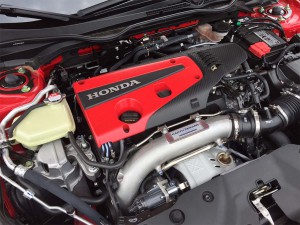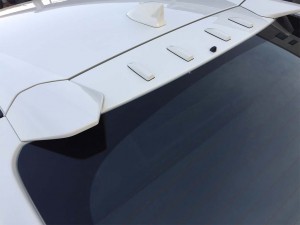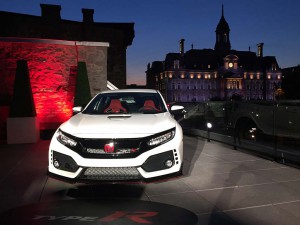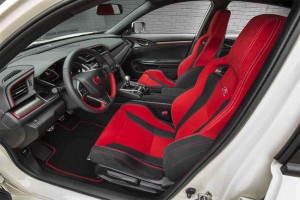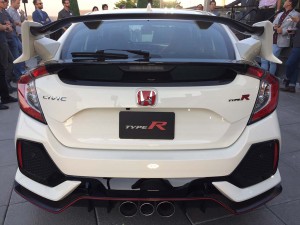Pity the poor American driver. Sure, they have plenty of options to choose from, but many of the most intriguing alternatives haven’t made it into U.S. showrooms. Until recently, that included some of the most exciting offerings in the hot hatch segment, like the Ford Focus RS and the Honda Civic Type-R.
We’ll have to wait a bit longer to get our hands on the Blue Oval’s entry, but we had the good fortune to spend a long weekend in Montreal, first sitting back to watch the annual Formula 1 Grand Prix and then logging some track time of our own behind the wheel of the Type-R, the first version of the Honda five-door rocket ever to reach the U.S. market.
The latest and last entry into the largest line-up of Civic alternatives ever, the Type-R is also the most powerful, delivering a blistering 306 horsepower to the front wheels. From first glance, the five-door is also the most audacious, with the sort of aero treatment you’d expect on something specifically designed for the track. But it’s all functional, and despite some concerns about Honda’s decision to stay with a front, rather than all-wheel-drive layout, it all magically comes together. And with a starting price as much as $5,000 less than key competitors, this hot hatch seems destined to become a hot ticket.
Honda introduced the first Civic Type-R back in 1997, updating it four more times by 2015. The last version was based on a Civic platform designed specifically for the European and Japanese home markets. Homologating it – bringing it into compliance with U.S. safety and emissions standards – was simply going to be too costly, even though it was beginning to look like there really was an American market for hot hatches like the Volkswagen Golf-R and, of course, the Subaru WRX STI.
The good news came with the development of the newest, and globalized, Civic platform. Since the new Type-R would start out with the same underpinnings as the plain vanilla Civic line, it suddenly became not only possible, but logical, to finally introduce it to U.S. buyers.
The 2017 Type-R is longer than the outgoing hatchback, but lower and ever so slightly narrower. By the numbers, it measures 179.5 inches, nose-to-tail, with a 106.2-inch wheelbase. It’s 56.5 inches in height and 73.8 inches in width.
Visually, you’ll recognize the Civic family resemblance, but beyond the lower ride height there are significant exterior revisions, starting with the distinctive red Honda badge reserved specifically for Type-R models.
The vast majority of the body revisions have been made specifically to enhance aerodynamics, and this is clearly a case of beauty being in the eye of the beholder. To some, the Civic Type-R might look like a confusing hodgepodge of design elements. But here is where function leads form, each detail essential to the hatchbacks performance.
That starts with the various grilles and ports, as well as the hood scoop are functional and designed to feed air into the engine, keep he powertrain cool and improve airflow. There are air scoops to both cool the brakes and reduce turbulence around both front and rear wheels. Winglets on the front corners improve airflow while also adding some downforce at high speeds. When you’re building a car like this, with a top speed in the 170 mph range, downforce is critical, and even the design of the side rockers and sills play a role.
There are twin rear wings, a flat belly pan, and Honda designers and engineers even worked in some subtle roof strakes to create vortices directing air over those wings.
But what really matters most is what’s just barely concealed under the hood, a snarling, turbocharged 2.0-liter inline-four that punches out 306 horsepower – about 10 less than the Euro/Japanese Type-R – and 295 pound-feet of torque. That power comes on impressively quickly, with absolutely no sense of turbo lag, and the Type-R keeps pulling all the way up to its 7,000 RPM redline. Credit such touches as a low-inertia turbocharger and electric wastegate allowing the engine to develop a full 23 psi of boost.
(The Type-E engine, incidentally, will find more use soon within the Honda family. Among other things, a slightly detuned version will show up as the upgrade package for the completely redesigned 2017 Honda Accord.)
(Click Herefor a first drive of the 2017 Accord.)
Power is pushed through a short-throw, six-speed manual gearbox – which takes a few moments to get the hang of, especially when cruising, as it tends to try to downshift when you might actually be reaching for sixth. As we noted, power is delivered exclusively through the front wheels.
With key competitors – notably Ford with the new Focus RS – going all-wheel-drive, Honda’s approach has generated a fair bit of criticism and close scrutiny. But the mood among media members gathered for this week’s drive shifted notably as we all started clocking laps on the iCar race circuit in Mirabel and then along the twisty Laurentian Mountain roads north of Montreal.
The car provides three driving modes, in fact: Comfort, Sport and +R, each adjusting a variety of vehicle settings, including steering boost, throttle response and the dynamic damping system. While +R reduces the intrusiveness of nanny features like electronic stability control it doesn’t shut them off entirely.
Firing up the engine and switching to +R mode, we clicked the shifter into gear and lifted the clutch pedal. Launching down the pit lane, the first, satisfying impression was the complete absence of any torque steer. Heading into Turn 1, we also were pleased by the lack of any tendency to push into corners that can be the Achilles Heel of all-wheel-drive platforms.
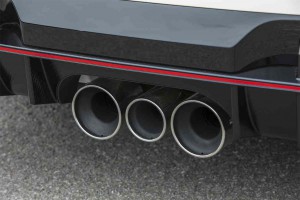
The center pipe is actually a resonator, boosting grumble at low speeds, reducing noise at high revs.
As we weaved and bobbed around the 2.3-mile course and worked our way through the gearbox we found no need to heel and toe launching into the iCar circuit’s corners. The Type-R automatically rev matches – though you can switch that feature off, if you so desire.
There’s one switch we wish Honda would have added. One of the more unusual features of the Type-R is the third exhaust pipe. It’s actually a resonator that helps the Civic hot hatch deliver a satisfyingly throaty note at low revs. Surprisingly, it also tends to reduce the noise level as you build speed. That’s fine on long drives, reducing stress levels, but while driving in anger we’d love to be able to bypass the resonator and here the engine working in all its glory.
Lap after lap, we found the Civic Type-R inspiring the sort of confidence that lets you steadily build up speed. We kept pushing farther into the corners before clamping the big Brembo brakes – 4-piston, 13.8-inch cross-drilled rotors up front and a 12.0-inch single roto package in the rear. Over-cooking the corners could be disastrous were the Type-R not so sure-footed. But we seldom heard more than a brief squeal from the 20-inch low-profile Continental SportContact performance rubber.
Several factors complement the grip of those 245/30ZR20 shoes. Start with a dual-axis strut front suspension and a multi-link rear, along with dual anti-roll bars. There’s also had continuously variable Adaptive Damper System which is an upgraded – meaning faster and more precise — version of what’s offered in the also-new Honda Civic Si. It constantly monitors steering angle, as well as yaw, pitch, and road conditions using suspension stroke and G sensors.
(Click Here for a test drive of the new Honda Civic Si.)
On track, we remained in +R Mode, only briefly switching to Sport. The difference was subtle but clear, with steering and throttle response notably tightening up.
How fast is it? While Honda is confirming a top speed in excess of 170 mph, they’re not giving precise 0 to 60 times. Initial reviews suggest something in the low 5-second range, however. What Honda does confirm is that a prototype version, only slightly modified (with roll cage added and a few tweaks to bring weight back down to production spec) it turned in a time of 7 minutes 43.80 seconds on the Nürburgring Nordschliefe. That’s an all-time record for a front-driver, and about 3 seconds faster than the prior model’s time.
Later on, as we finished up our track time and headed out on a 100-mile road tour, we finally switched into Comfort Mode. Let’s face it, nothing wearing such low profile tires will give you a limousine-like ride, but the Type-R would do a passable job as a daily driver – as long as you don’t have the sort of deep potholes found across Michigan. We’d be loath to put it out on the road during a winter snowstorm but while Honda doesn’t officially offer winter tires there are several options available, we were told, on the aftermarket.
There’s one other number likely to impress potential buyers. At $34,775 – including delivery charges – the 2017 Honda Civic Type R is thousands of dollars less than the Focus RS, WRX STI and Golf R. It’s also about the best-equipped of the classmates, with Touring Level features that include a navigation system, auto-on LED headlights and techie features like Apple CarPlay and Android Auto. There are also surprisingly comfortable yet supportive front sport seats. Beyond exterior color, there are no options.
After a nearly two-decade wait, it’s nice to see the Honda Civic Type-R show up in the U.S. – with sales beginning this week. The five-door is quick, responsive and an absolute hoot to drive hard. It’s also surprisingly comfortable and readily manageable in less aggressive driving. If this is what Honda was aiming for all these years, the new Type-R was well worth the wait.
(Late to the game, maybe, but Honda has big plans for autonomous vehicles. Click Here for this inside report.)


